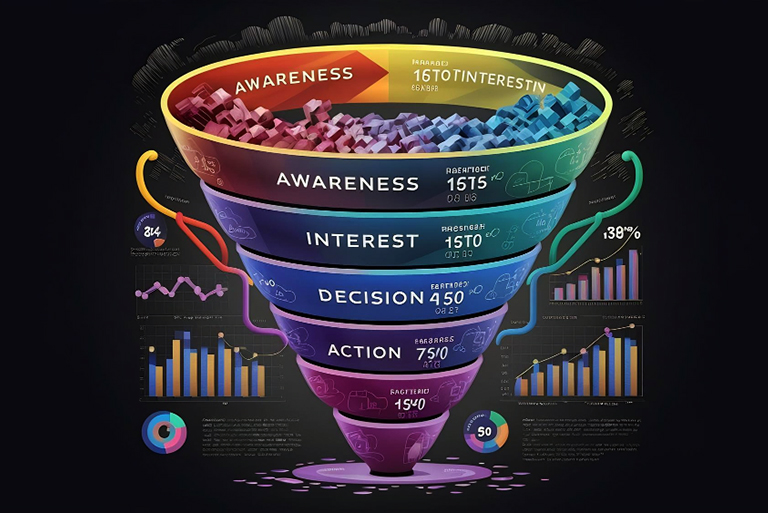- info@uxgenmarketing.com
- U-211, Vaishnav Enclave, Sec 67A. Gurugram. Haryana. 122101
Smart Funnels, Smarter Growth: How Data-Driven Marketing Converts Better

Smart Funnels, Smarter Growth: How Data-Driven Marketing Converts Better
Funnels are at the heart of digital marketing. They guide users from awareness to conversion, helping brands structure campaigns that deliver measurable results. But in today’s data-rich, attention-scarce environment, having a basic funnel isn’t enough. Smart funnels—designed around behavior, automation, and analytics—are driving the next phase of performance marketing.
Smart funnels are built to adapt. They analyze how users move, think, and act across channels, allowing marketers to serve the right message at the right moment. This level of intelligence transforms funnels from static journeys into dynamic systems that reduce waste, lower acquisition costs, and convert more efficiently.
This blog unpacks how data-driven funnels work, why they outperform traditional ones, and how brands can use them to scale digital growth.
What Makes a Funnel “Smart”?
A smart funnel is a performance-optimized framework that uses real-time data, audience signals, and automation to guide potential customers through the buyer journey.
It differs from traditional funnels in the following ways:
-
Built on analytics rather than assumptions
-
Powered by marketing automation tools
-
Personalized based on user behavior
-
Continuously tested and optimized
The goal of a smart funnel is not just to generate leads or traffic, but to drive efficient, scalable conversions across multiple channels.
Ready to audit your funnel performance? Let our experts analyze what’s working—and what’s not.
Building Smarter Funnels: Key Components
1. Audience Segmentation
The first step in any smart funnel strategy is understanding who the audience is. Segmentation goes beyond demographics to include user behavior, source of traffic, intent level, and previous interactions.
Using data from CRMs, analytics platforms, ad managers, and website behavior, marketers can group users into more meaningful clusters. Each group receives content and messaging that directly matches their stage in the funnel and level of readiness to convert.
The more precise the segmentation, the more effective the targeting—and ultimately, the more efficient the funnel.
2. Funnel Automation
Automation is what makes a smart funnel scalable. With tools like HubSpot, Meta Ads Manager, ActiveCampaign, and Google Ads, marketers can create automated workflows that respond to specific user actions.
Examples include:
-
Sending follow-up emails after a product page visit
-
Triggering remarketing ads when someone abandons a cart
-
Changing call-to-action based on traffic source or location
These automated steps improve engagement without requiring manual intervention, keeping users consistently moving forward in the funnel.
3. Data-Backed Testing and Optimization
Every step of the funnel should be tested and iterated using hard data. This includes headlines, imagery, landing page layout, button text, email sequences, and ad copy.
Using tools like Google Optimize, VWO, or analytics dashboards, marketers can track performance metrics such as:
-
Conversion rate at each funnel stage
-
Cost per lead and cost per acquisition
-
Time spent on key pages
-
Drop-off points in the funnel
By monitoring these signals, brands can continuously refine their funnel and eliminate underperforming assets that reduce ROI.
4. Multi-Platform Integration
Consumers interact with multiple channels before converting—search, social media, email, websites, WhatsApp, and even SMS. Smart funnels connect these platforms to create a unified experience.
This means a user who sees a YouTube ad, visits the website, and drops off can later receive a tailored email or see a reminder offer on Instagram. The funnel doesn’t restart with each channel—it adapts based on where the user left off.
This kind of multi-platform synchronization helps maintain momentum, reducing churn and improving conversion consistency.
Turn your traffic into real growth with a high-converting smart funnel built by UXGen Marketing.
Measuring Funnel Success
Smart funnels thrive on performance tracking. Beyond basic metrics like impressions and clicks, marketers should evaluate:
-
Funnel stage conversion rates
-
Customer acquisition cost (CAC)
-
Return on ad spend (ROAS)
-
Cost per qualified lead
-
Time to conversion
These metrics provide a clear picture of what’s working and where the funnel is leaking. The insights also help allocate budgets more efficiently by prioritizing the most profitable channels and segments.
Reducing Acquisition Costs Through Smarter Funnels
One of the biggest benefits of smart funnels is their ability to reduce customer acquisition costs. By targeting more qualified users, automating the nurture process, and optimizing messages in real time, brands spend less to acquire each customer.
Instead of relying on broad campaigns that drive general traffic, smart funnels focus on high-intent users and guide them through a more personalized journey. This leads to better conversion rates, higher lead quality, and more efficient use of advertising budgets.
Funnel Personalization at Scale
Modern marketing demands personalization, but delivering it at scale requires a structured system. Smart funnels make personalization possible by dynamically adjusting messaging based on factors such as:
-
User location
-
On-site behavior
-
Previous purchases or visits
-
Traffic source
-
Funnel stage
This level of personalization enhances the user experience and builds trust over time. When people feel understood, they are far more likely to convert.
Common Mistakes in Funnel Design
While smart funnels offer significant advantages, they require careful planning and execution. Common pitfalls include:
-
Using generic messaging across all stages
-
Failing to retarget drop-offs effectively
-
Ignoring mobile funnel behavior
-
Overloading users with irrelevant touchpoints
-
Not testing enough variations
Avoiding these mistakes is essential for maintaining a healthy, high-performing funnel that delivers business results.
How UXGen’s Ecosystem Enables Smarter, Scalable Growth
Smart funnels and high-performing campaigns don’t operate in silos. They work best when backed by aligned strategies across design, learning, and execution. UXGen’s ecosystem is designed to enable this alignment—bringing together specialized teams that address the full spectrum of digital transformation. Each venture plays a distinct but connected role in helping brands scale with precision and clarity.
Key Roles of UXGen ecosystem:
-
UXGen Design Studio
Builds conversion-focused digital experiences through research-led visual design, content architecture, and interface strategy that support stronger funnel performance. -
UXGen Academy
Equips marketing and design professionals with the mindset, tools, and workflows needed to design smarter campaigns and understand user behavior at a deeper level. -
UXGen Marketing
Crafts data-driven funnels, ad strategies, and performance marketing systems that directly impact lead quality, ROAS, and customer acquisition efficiency. -
Provides scalable technical solutions, automation infrastructure, and platform integrations to support seamless funnel execution and cross-channel personalization.
Conclusion
Smart funnels represent the evolution of digital marketing. They combine automation, behavioral targeting, and performance data into a single system that doesn’t just push content—it guides users through meaningful, measurable journeys.
As the digital landscape becomes more competitive, brands that rely on manual marketing tactics will fall behind. The future belongs to businesses that adopt systems engineered for agility, scale, and outcome-driven growth.
For digital marketers, this means embracing data at every level of the funnel and aligning strategy with real-time insights. It’s not just about converting traffic—it’s about converting better, faster, and smarter.
Frequently Asked Questions
1. What is a smart funnel in digital marketing?
A smart funnel is a performance-optimized marketing structure that uses audience behavior, automation, and data to deliver personalized journeys. Unlike traditional funnels, it adapts in real-time and aims to increase efficiency at every stage.
2. How does a smart funnel reduce customer acquisition costs?
By segmenting audiences, automating interactions, and focusing on high-intent users, smart funnels improve conversion rates and reduce wasted ad spend. This leads to lower customer acquisition costs and better return on investment.
3. Can smart funnels be applied to any business type?
Yes. Whether you’re a D2C brand, a SaaS company, a coaching business, or an eCommerce store, smart funnels can be customized to suit your audience, platform, and sales cycle.
4. What tools are commonly used to build smart funnels?
Popular tools include Meta Ads Manager, Google Ads, HubSpot, ActiveCampaign, Zapier, Google Analytics, and email marketing platforms with automation features.
5. What metrics should I track to evaluate funnel performance?
Key metrics include conversion rate by funnel stage, customer acquisition cost (CAC), return on ad spend (ROAS), time to conversion, and lead-to-sale ratio.







